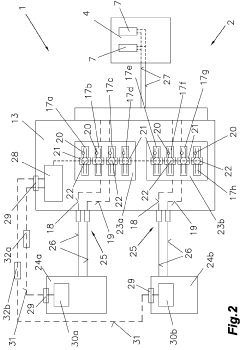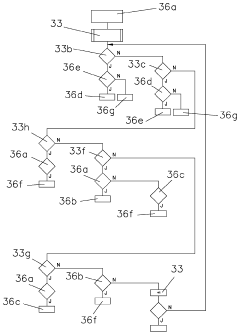Integrated Flow Conditioning In Check Valves: Enhancing Efficiency
Technology Background And Goals
Additionally, it will outline the geographical distribution of this technology, highlighting regions or countries that have made significant advancements or possess unique strengths in this domain.
Check Valves Market Demand Analysis
- Market Size and Growth
Analyze the current and projected market size for check valves with integrated flow conditioning. Provide estimates for different regions and industries, highlighting areas with significant growth potential. - Application Domains
Identify key application domains where check valves with flow conditioning are in high demand, such as oil and gas, chemical processing, power generation, and water treatment. Discuss specific use cases and requirements in each domain. - Customer Segments
Outline the major customer segments for these valves, including industrial plants, utilities, and OEMs. Assess their unique needs, preferences, and purchasing criteria. - Competitive Landscape
Evaluate the competitive landscape, including major players, their market shares, and product offerings. Highlight any gaps or unmet needs in the market. - Regulatory and Standards
Discuss relevant industry regulations, standards, and certifications that impact the design, manufacturing, and deployment of these valves in different regions and applications.
Technology Status And Challenges
- Valve Design Evolution
Tracing the development of check valve designs, from traditional swing and lift types to advanced configurations like tilting disc and double-door designs, aimed at improving flow characteristics and reducing pressure losses. - Flow Conditioning Challenges
Identifying key challenges in integrating effective flow conditioning elements within check valves, such as minimizing turbulence, ensuring uniform velocity profiles, and mitigating swirl and distortions. - Pressure Drop Reduction
Exploring strategies to reduce pressure drops across check valves with integrated flow conditioners, including optimized valve geometries, streamlined flow paths, and advanced computational fluid dynamics (CFD) simulations. - Material and Manufacturing Considerations
Discussing material selection criteria and manufacturing techniques to ensure durability, corrosion resistance, and cost-effectiveness of integrated flow conditioning check valves for various industrial applications.
Current Technical Solutions
01 Spring-loaded Closure Mechanisms
These check valves use a spring-loaded mechanism to control opening and closing, allowing one-way flow control and preventing backflow.- Valve Structure and Components: Check valves have specific structures and components like valve bodies, seats, discs/balls, springs, and guides. These components' arrangement and materials affect performance and durability.
- Applications and Industries: Check valves are used in water supply, chemical processing, oil and gas, and automotive industries to prevent backflow, maintain pressure, and ensure proper fluid flow direction.
- Materials and Coatings: Check valves can be made from metals, plastics, or composites, with coatings or treatments for corrosion resistance, wear resistance, and other properties.
- Design and Performance Optimization: Check valve designs can be optimized for flow capacity, pressure drop, leakage prevention, and response time by considering geometry, materials, spring characteristics, and flow path configurations.
- Testing and Maintenance: Check valves require periodic testing (pressure, leak, functional) and maintenance (cleaning, inspection, component replacement) to ensure proper operation and prevent failures.
02 Ball or Piston-type Closure Elements
These check valves employ a ball or piston-type closure element that moves within the valve body to control flow direction and prevent backflow.Expand Specific Solutions03 Disc or Flapper-type Closure Elements
These check valves utilize a disc or flapper-type closure element that swings or pivots to control flow direction and prevent backflow, suitable for low-pressure differential applications.Expand Specific Solutions04 Lightweight or Buoyant Closure Elements
These check valves incorporate lightweight or buoyant closure elements that move freely with fluid flow, suitable for low fluid velocity applications.Expand Specific Solutions05 Specialized Designs for Specific Applications
These check valves have unique features or configurations tailored for specific applications or operating conditions, such as high-temperature environments, corrosive fluids, or compact/lightweight designs.Expand Specific Solutions
Main Player Analysis
Honeywell International Technologies Ltd.
Lontra Ltd.
Key Technology Interpretation
- The integrated valve allows data exchange with connected devices, enabling better control and monitoring of the temperature control process.
- The integrated valve design simplifies the temperature control system by combining multiple components into a single unit.
- The integrated valve is specifically designed for temperature control applications in injection molding, die casting, and extrusion processes, tailoring its functionality to the unique requirements of these industries.
Check Valves Integrated Flow Conditioning Economic Analysis
The analysis includes the initial investment required for research, development, and implementation, as well as the potential long-term cost savings and revenue generation opportunities.
One key aspect to consider is the potential reduction in operational and maintenance costs resulting from improved flow conditioning. Effective flow conditioning can mitigate issues such as turbulence, pressure fluctuations, and cavitation, which can lead to premature wear and failure of downstream equipment. By minimizing these problems, the integration of flow conditioning devices into check valves could potentially extend the lifespan of critical components and reduce the frequency of repairs and replacements, ultimately translating into cost savings over the long term.
Additionally, the economic analysis should consider the potential for increased efficiency and productivity gains. Improved flow conditions can enhance the overall performance of fluid systems, leading to higher throughput, reduced energy consumption, and improved process control. These benefits can result in cost savings and increased revenue generation opportunities, making the technology a potentially attractive investment for industries relying on fluid systems.
Furthermore, the analysis should account for the potential market demand and competitive landscape. If the integrated flow conditioning technology offers significant advantages over existing solutions, it could provide a competitive edge and open up new market opportunities, thereby generating additional revenue streams for the adopting companies.
Check Valves Integrated Flow Conditioning Policy And Regulatory Impact
The regulatory impact of check valves with integrated flow conditioning is a crucial aspect that requires careful consideration. These specialized valves, designed to improve flow conditions and mitigate issues like turbulence and cavitation, are subject to various industry standards and regulations to ensure safety, reliability, and performance.
In many industries, such as oil and gas, chemical processing, and power generation, check valves play a critical role in controlling the flow of fluids and preventing backflow. The integration of flow conditioning devices within these valves introduces additional design considerations and potential regulatory implications.
Regulatory bodies often mandate strict guidelines for the design, testing, and installation of check valves, especially in safety-critical applications. These regulations aim to minimize the risk of equipment failure, environmental incidents, and potential hazards to personnel and infrastructure.
Compliance with industry-specific codes and standards is essential for the widespread adoption and acceptance of check valves with integrated flow conditioning. Manufacturers must ensure that their products meet the relevant requirements set forth by organizations like the American Society of Mechanical Engineers (ASME), the American Petroleum Institute (API), or the International Organization for Standardization (ISO).
Furthermore, regulatory agencies may impose specific certification processes, material specifications, or performance testing protocols for these specialized valves. This could include requirements for computational fluid dynamics (CFD) simulations, flow loop testing, or field trials to validate the effectiveness of the integrated flow conditioning devices.
Environmental regulations also play a role, particularly in industries with strict emission controls or where the release of hazardous substances could pose significant risks. Ensuring proper flow conditions and minimizing turbulence can contribute to improved operational efficiency and reduced environmental impact.
In summary, the regulatory impact on check valves with integrated flow conditioning encompasses a wide range of considerations, including compliance with industry standards, adherence to safety and performance guidelines, environmental regulations, and certification processes. A comprehensive understanding of the applicable regulations and close collaboration with regulatory bodies are essential for the successful development, deployment, and acceptance of these innovative valve solutions.



